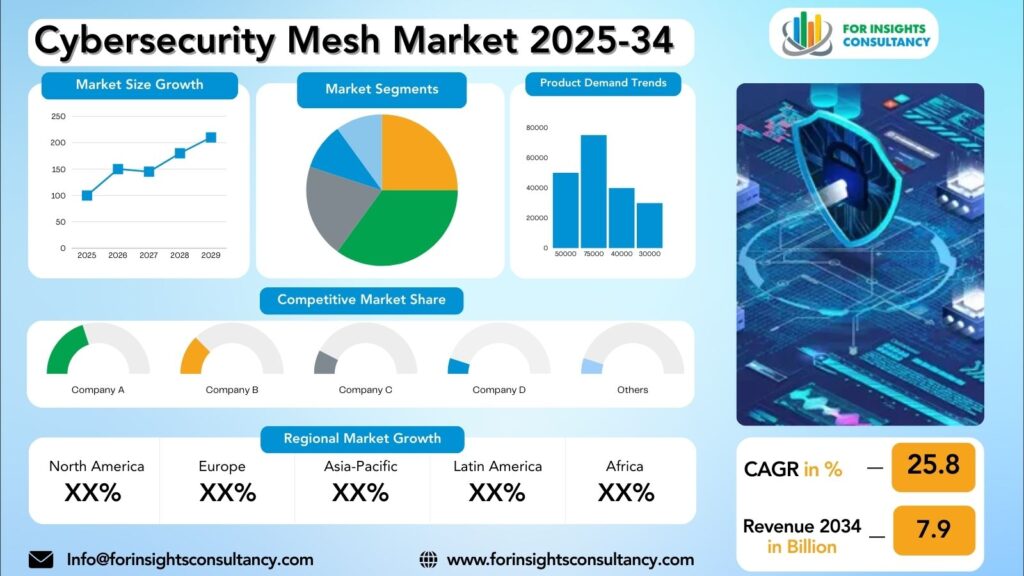
Cybersecurity Mesh Market Research Report by Component (Solutions, Services), By Deployment Mode (On-Premise, Cloud, Hybrid), by Organization Size (Large Enterprises, Small and Medium-sized Enterprises (SMEs)), by End-Use Industry, and Region Global Market Analysis and Forecast, 2025-2034
Aug-2025 Formats | PDF | Category: IT | Delivery: 24 to 72 Hours
Cybersecurity Mesh Market is forecast to increase from USD 1.8 Billion in 2025 to USD 7.9 Billion by 2034, at a CAGR of 25.8%.
Cybersecurity Mesh Market: A Comprehensive Overview and Future Developments
In the digital age, cybersecurity is crucial for organizations to stay ahead of cyber threats. The cybersecurity mesh market is emerging, offering a decentralized approach to securing digital assets and workloads, regardless of their location. This approach extends security controls to individual devices, applications, and data, enhancing security posture and protecting against sophisticated threats.
The market is expected to continue innovation and development, with emerging technologies like quantum computing, 5G networks, and edge computing shaping the future of cybersecurity. Organizations must remain agile and proactive in addressing emerging threats and adapting to changing security requirements. Future predictions for the cybersecurity mesh market include increased emphasis on data privacy and compliance, convergence of cybersecurity and physical security, a risk-based approach, and the development of integrated security platforms.
Cybersecurity Mesh Market Dynamics
Growth Drivers
The cybersecurity mesh market is experiencing rapid growth due to increasing cyber threats, digital transformation, remote workforce, regulatory compliance, and business continuity. Cyber threats are becoming more sophisticated, leading organizations to seek advanced security solutions to mitigate risks and protect assets. The shift towards remote work arrangements has increased vulnerability to cyber threats, necessitating robust cybersecurity solutions for distributed environments. Stricter data protection and privacy regulations are driving organizations to invest in comprehensive security solutions like cybersecurity mesh to avoid fines. Business continuity is a top priority, prompting organizations to invest in innovative security technologies to provide continuous protection against cyber threats.
Restraints
The cybersecurity mesh market faces several challenges, including increased complexity, integration challenges, scalability concerns, and resource constraints. Traditional cybersecurity solutions often operate in silos, with each tool serving a specific purpose. The cybersecurity mesh model aims to integrate these disparate tools into a cohesive network, offering greater visibility and control over security threats but also introducing complexity that organizations may struggle to manage effectively.
Integration challenges involve ensuring compatibility and seamless communication between diverse security tools and technologies, which requires significant investment of time and resources. Additionally, integrating legacy systems with newer technologies can present compatibility issues that need to be addressed.
Scalability concerns arise as businesses grow and their digital footprint expands, necessitating careful planning for scalability to avoid gaps in protection. This may require additional investments in infrastructure and resources to support the growing security infrastructure.
Resource constraints are another significant challenge for organizations adopting the cybersecurity mesh model. Implementing and maintaining a cybersecurity mesh requires significant investment of time, money, and expertise, including training employees, updating technologies, and monitoring security threats. Additionally, the cybersecurity talent shortage presents a significant challenge, as organizations may struggle to find skilled professionals capable of managing a cybersecurity mesh effectively.
Opportunities
Cybersecurity mesh offers organizations enhanced visibility and control by providing real-time insights into their network and devices, enabling them to identify and respond to threats more effectively. It also enhances resilience by decentralizing security controls, allowing for dynamic response in case of breaches or attacks. The mesh is highly scalable and flexible, suitable for organizations of all sizes and industries, from startups to large enterprises. It also offers cost-effective security, as it reduces reliance on traditional, costly, and complex solutions. By leveraging cloud-native security controls, organizations can contain and mitigate the impact of security incidents, making it an ideal solution for organizations looking to enhance their security posture without breaking the bank.
Challenges
The cybersecurity mesh market faces significant challenges, but organizations can overcome them by adopting a holistic approach that integrates people, processes, and technology. This includes implementing a Zero Trust Security Model, investing in threat intelligence, automating security processes, and investing in cybersecurity training. By assuming every user and device is a potential threat, organizations can reduce the risk of unauthorized access to sensitive data. Automation tools and technologies can streamline security operations and respond more quickly to incidents. Investing in cybersecurity training empowers employees to recognize and respond effectively to security threats.
Cybersecurity Mesh Market Top Companies Covered In This Report:
Evaluate The Strategic Positioning And Innovation Pipelines Of Leading Market Companies-From Multinational Enterprises To Disruptive Regional Firms. Understand How Key Players Are Innovating, Expanding, And Capturing Value, And Use Competitive Benchmarks To Plan Your Next Move.
- Zscaler (US)
- IBM (US)
- Palo Alto Networks (US)
- Check Point (Israel)
- Fortinet (US)
- GCA Technology (US)
- Forcepoint (US)
- SonicWall (US)
- Ivanti (US)
- Cato Networks (Israel)
- Aryaka Networks (US)
- SailPoint (US)
- appNovi (US)
- Appgate (US)
- Mesh Security (Israel)
- Primeter 81 (Israel)
- Naoris Protocol (Portugal)
- Exium (US).
Cybersecurity Mesh Market News
IBM
X-Force 2025 Threat Intelligence Index: IBM’s report highlighted the escalating threat landscape and positioned its solutions as essential for a proactive defense. The report specifically mentioned “identity fabrics” as a way to unify disconnected data and identity silos, a key concept within a cybersecurity mesh.
Palo Alto Networks
The company’s 2025 predictions for the Asia-Pacific region emphasized a shift towards a single, unified data security platform. This platform approach, which reduces the number of security tools and provides end-to-end visibility, is a practical application of the cybersecurity mesh principle.
Segmented View of the Industry:
The Cybersecurity Mesh Market Is Mapped Through A Multidimensional Lens-Tracking Shifts Across Product Type, Applications, And Geographic Regions. This Segmented Approach Enables Businesses To Localize Their Growth Plans And Align Offerings With The Most Profitable Demand Centers.
Segmentation by Deployment Mode
- On-Premise
- Cloud
- Hybrid
Segmentation by Organization Size
- Large Enterprises
- Small and Medium-sized Enterprises (SMEs)
Segmentation by Component
- Solutions
- Services
Segmentation by End-Use Industry
- BFSI (Banking, Financial Services, and Insurance)
- Retail
- Healthcare
- IT and Telecom
- Government and Defense
- Manufacturing
- Other industries
Global Geographic Coverage:
The Report Provides In-Depth Qualitative and Quantitative Data On the Cybersecurity Mesh Market For All Of The Regions And Countries Listed Below:
North America
North America is a major player in the cybersecurity mesh market, with the United States leading the way in adoption and investment. The country has a strong cybersecurity infrastructure and is home to some of the world’s leading cybersecurity companies. Canada is also a key player, with a growing number of organizations investing in cybersecurity solutions to protect their data and systems. The increasing number of cyber threats and attacks has prompted organizations to enhance their cybersecurity measures, driving the demand for cybersecurity mesh solutions. Canada’s stringent data protection laws and regulations have made cybersecurity a top priority for businesses, leading to a rising demand for cybersecurity mesh solutions in the country.
Europe
Germany, the leading player in the cybersecurity industry, is experiencing significant growth in the cybersecurity mesh market due to the increasing number of cyber threats faced by businesses and government entities. The demand for advanced security solutions, such as zero-trust architecture and secure access service edge (SASE), is on the rise in Germany. The UK, another key player in the market, is also experiencing rapid growth due to the increasing number of cyber attacks targeting businesses and government agencies.
The adoption of cloud-based security platforms and AI-driven threat detection systems is also driving the growth of the cybersecurity mesh market. France, another key player in the market, is investing heavily in cybersecurity infrastructure to protect its critical national assets from cyber threats. Spain, on the other hand, is experiencing rapid growth due to the digitization of businesses and public services, focusing on strengthening its cybersecurity capabilities to combat evolving threats effectively.
Asia Pacific
China, a leading technology hub, is experiencing a rapidly growing cybersecurity market due to its investment in advanced security solutions. With the rise of e-commerce and digital payment systems, there is a growing need for robust measures to protect financial transactions and consumer data. The adoption of cybersecurity mesh technology is gaining traction in China, as organizations seek to build a more resilient and adaptive security framework. Japan, known for its technological innovation and advanced cybersecurity capabilities, is implementing stringent cybersecurity regulations to protect critical infrastructure and sensitive data. With the increasing number of cyber attacks targeting Japanese organizations, there is a growing demand for advanced security solutions like cybersecurity mesh.
India, home to a thriving IT industry and a burgeoning cybersecurity market, is investing in cybersecurity mesh solutions to enhance security resilience and protect against sophisticated threats. The Indian government is actively promoting cybersecurity awareness and encouraging the adoption of advanced security technologies to secure the digital ecosystem. South Korea, known for its advanced technological infrastructure and cyber capabilities, is also prioritizing cybersecurity. The adoption of cybersecurity mesh technology is on the rise in South Korea, as companies seek to build a more integrated and adaptive security framework to detect and respond to cyber threats effectively.
Middle East and Africa
The Middle East is a growing hub for cybersecurity innovation, with countries like Israel, the UAE, and Saudi Arabia leading the way. These countries have invested heavily in cybersecurity research and development, attracting top talent and companies from around the world. The cybersecurity mesh market in the Middle East is driven by the increasing number of cyber threats faced by businesses, such as government institutions, financial services, and critical infrastructure. Companies are increasingly turning to cybersecurity mesh solutions to protect their networks and data.
The Middle East cybersecurity market is expected to grow significantly in the coming years, driven by increased investments in cybersecurity infrastructure and the adoption of advanced technologies like artificial intelligence and machine learning. Companies in the region are focusing on cybersecurity as a key priority, recognizing the potential financial and reputational damage from a cyber attack.
Africa faces unique challenges in the cybersecurity landscape, with limited resources and infrastructure. However, there is a growing awareness of the importance of cybersecurity in the region, leading to increased investments in cybersecurity solutions. One key trend in the cybersecurity mesh market in Africa is the adoption of cloud-based security solutions. Governments and businesses in the region are investing in cybersecurity infrastructure, creating opportunities for cybersecurity vendors and service providers to expand their presence in the African market.
Reasons to Buy:
- The Research Would Help Top Administration/Policymakers/Professionals/Product Advancements/Sales Managers And Stakeholders In This Market In The Following Ways.
- The Report Provides Cybersecurity Mesh Market Revenues At The Worldwide, Regional, And Country Levels With A Complete Analysis To 2034 Permitting Companies To Analyze Their Market Share And Analyze Projections, And Find New Markets To Aim For.
- To Understand The Most Affecting Driving And Restraining Forces In The Market And Their Impact On The Global Market.
- Major Changes And Assessment In Market Dynamics And Developments.
- The Objective Of The Cybersecurity Mesh Market Report Is To Identify New Business Opportunities Using Quantitative Market Forecasts.
- Formulate Sales And Marketing Strategies By Gaining An Understanding Of Competitors, Their Positioning, And Strengths & Weaknesses.
Faq – What Global Leaders Are Asking
What Is The Growth Prospect For The Cybersecurity Mesh Market By 2034?
Cybersecurity Mesh Market Is Expected To Achieve A Stable Growth Rate With A Compound Annual Growth Rate (Cagr) Of About 25.8% From 2025 Through 2034.
What Is Driving The Growth Of The Cybersecurity Mesh Market?
The growth of the cybersecurity mesh market is driven by the increasing complexity of modern IT environments, including hybrid work and multi-cloud platforms, which have rendered traditional perimeter-based security ineffective. This has created a critical need for a more integrated and flexible security architecture that can provide consistent protection across a decentralized network of devices and users.
Who Are The Key Players In The Cybersecurity Mesh Market, And What Are Their Market Shares?
The Cybersecurity Mesh Market Includes Major Companies Like Zscaler (US), IBM (US), Palo Alto Networks (US), Check Point (Israel), Fortinet (US), GCA Technology (US), Forcepoint (US), SonicWall (US), Ivanti (US), Cato Networks (Israel), Aryaka Networks (US), SailPoint (US), appNovi (US), Appgate (US), Mesh Security (Israel), Primeter 81 (Israel), Naoris Protocol (Portugal), Exium (US).
Specific Market Share Data Is Not Publicly Available and Is Typically Provided In Detailed, Proprietary Market Research Reports.
Which Regions Are Leading the Cybersecurity Mesh Market Growth?
North America leads the cybersecurity mesh market in terms of overall revenue and market share, driven by a mature cybersecurity ecosystem and the early adoption of zero-trust frameworks. However, Europe and the Asia-Pacific region are projected to be the fastest-growing markets due to increasing cyber threats and government initiatives to enforce stricter security regulations and digital transformation across industries.
Customization: We Can Provide Following Things
1) On Market More Company Profiles (Competitors)
2) Data About Particular Country Or Region
3) We Will Incorporate The Same With No Additional Cost (Post Conducting Feasibility).
Any Requirement Contact Us: Https://Www.Forinsightsconsultancy.Com/Contact-Us/
Table of Contents
For TOC Contact us: https://forinsightsconsultancy.com/contact-us/






